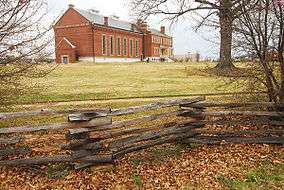Fort Smith National Historic Site
| Fort Smith National Historic Site | |
|---|---|
|
IUCN category V (protected landscape/seascape) | |
|
Part of historic Fort Smith | |
 | |
| Location | Sebastian County, Arkansas, United States |
| Nearest city | Fort Smith, Arkansas |
| Coordinates | 35°23′18″N 94°25′47″W / 35.388210°N 94.429834°WCoordinates: 35°23′18″N 94°25′47″W / 35.388210°N 94.429834°W |
| Area | 75 acres (30 ha) |
| Established | September 13, 1961 |
| Visitors | 86,122 (in 2011) |
| Governing body | National Park Service |
| http://www.nps.gov/fosm/index.htm | |
| Designated | October 15, 1966 |
| Reference no. | 66000202[1] |
| Designated | December 19, 1960 |
Fort Smith National Historic Site is a United States National Historic Site located in Fort Smith, Arkansas along the Arkansas River.
The site was established in 1961 in order to protect the remains of two 19th-century U.S. military forts, including a building which once housed the United States District Court for the Western District of Arkansas. Fort Smith was also notable as a major stop along the "Trail of Tears." It was designated a National Historic Landmark in 1960.[1][2]
The park visitor center is now located in the old Barracks/Courthouse/Jail building. Exhibits in the visitor center focus on Fort Smith’s military history from 1817–1871, western expansion, Judge Isaac Parker and the federal court's impact on Indian Territory, U.S. Deputy Marshals and outlaws, Federal Indian policy, and Indian Removal including the Trail of Tears.
Located on the grounds are the foundation remains of the first Fort Smith (1817–1824), the commissary building (c. 1838) and a reconstruction of the gallows used by the federal court. A walking trail along the Arkansas River includes wayside exhibits on the Trail of Tears. This was also one of the areas Bonnie and Clyde stopped at and they were killed after leaving.
Land on the Oklahoma bank of the Arkansas River was authorized to be included in the National Historic Site to preserve a historic viewshed, but has not been acquired.[3]
 The courtroom of "Hanging Judge" Isaac Parker
The courtroom of "Hanging Judge" Isaac Parker Site of the 1818 fort
Site of the 1818 fort Commissary building
Commissary building
See also
- List of National Historic Landmarks in Arkansas
- National Register of Historic Places listings in Sebastian County, Arkansas
References
- 1 2 "Fort Smith". National Historic Landmark summary listing. National Park Service. 2007-09-26.
- ↑ Frank B. Sarls, Jr. (December 10, 1958) National Survey of Historic Sites and Buildings: Fort Smith (First and Second Sites) and Judge Parker Courtroom, National Park Service and Accompanying 4 photos, exterior, from 1940 and undated.
- ↑ National Park Service, Fort Smith National Historic Site. Click "View Park Map" to see existing park boundary.
External links
| Wikimedia Commons has media related to Fort Smith National Historic Site. |
- Official site: Fort Smith National Historic Site
